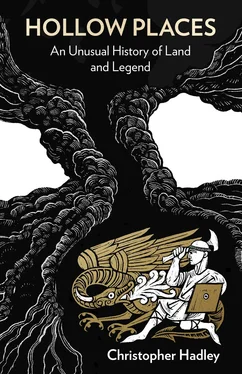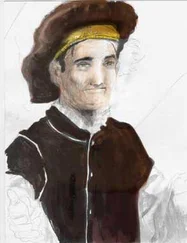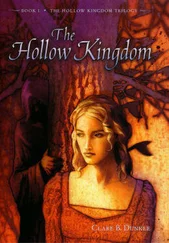Ancient trees have personalities and attract stories; it is hard not to think that this was an event in the life of the village. A crowd must have gathered that morning, if not to watch the iniquitous act, then to see the cavity. We know the Skinner family kept loppings, which hints at the value of the highly prized wood. No doubt, other villagers kept pieces as well if they could – to make spoons and knife handles. Peter Kalm, an eighteenth-century Scandinavian traveller, left an account of a tree he saw chopped down in Hertfordshire, describing the surprising number of people on the scene, wanting the leaves and roots and twigs for fuel or to make baskets. I imagine a host of villagers turning up that day. Nothing of that prized wood would be wasted. John Aubrey’s fair and spreading ewe-tree furnished him and the other schoolboys with nutt-crackers and scoopes to pull the flesh out of their apples. These would make fine souvenirs from a dragon’s lair.
I have often wondered what was made of the yew. If anything has survived. I have started to keep an eye on the local antique auctions, hoping to find a Windsor chair from the right period. I know what I am looking for. The wood mustn’t be too dark. The seat needs to be elm and shaped like the flagstones of a castle staircase, as if worn by years of use. And it has to be a stick back, no splat, with two hoops of yew, one for the back and one for the elbows, burnished to a rich honey, the tight grain bewitching and warm, taken from a tree with a dragon in its story. I’ll know it when I see it.
Saint Augustine saith, that Dragons doe abide in deep Caves and hollow places of the earth, and the some-times when they perceive moistnes in the ayre, they come out of theyr holes, and beating the ayre with their wings, as it were with the strokes of Oares, they forsake the earth and flie aloft
— Edward Topsell, The Historie of Serpents , 1608
In the rocks of Jaffa, south of Tel Aviv, rest the last bones of the dragon that Perseus slew to save Andromeda. The skulls of similar monsters litter the Sivalik hills in Northern India, and on Turkey’s Aegean coast the remains of fabulous creatures, which stalked the myths of Heracles, weather from the cliffs to astonish passing travellers.
Heracles’ victory against the Monster of Troy is depicted most dramatically on an ancient Greek krater, or vase, now in the Museum of Fine Arts in Boston. Here is the beast peppered with arrows by the hero as he rescues the Trojan princess Hesione. It is a very peculiar monster: just a head, white and skeletal, but to the modern eye it is impossible to mistake what we are looking at – a fossilised skull of a prehistoric creature projecting from a rocky outcrop; it is a two-and-a-half thousand-year-old black-figure masterpiece of palaeontology.
The vase appears on the cover of Adrienne Mayor’s The First Fossil Hunters , a compelling account of fossil finds in antiquity, which argues that dragons, griffins, cyclops and many other nightmares from the ancient world were inspired by the remains of dinosaurs and other prehistoric creatures. Mayor amasses accounts and archaeological evidence of encounters with giant bones in antiquity, alongside known fossil sites today, which dovetail neatly with the places where the legends of particular monsters first appeared.
In the first century CE, Apollonius of Tyana claimed to have seen dragon skulls in India where today we know the skulls of prehistoric giraffes, elephants and crocodiles are found in the famous Sivalik fossil beds. The Roman naturalist Aelian recorded the discovery of giant bones on the island of Chios following a forest fire and noted that the locals decided they must be the bones of a dragon: ‘From these gigantic bones the villagers were able to observe how immense and awful the monster was when it was alive.’ As for the dragons at Jaffa, biblical Joppa, a story from Ancient Rome tells how the consul Marcus Aemilius Scaurus held victory celebrations during which he paraded an immense skeleton found at Joppa, where tradition said the Greek hero Perseus rescued Andromeda from the dragon. One version of that myth even says that Perseus turned the monster to stone – petrified it, fossilised it perhaps?
W. B. Gerish entertained similar ideas about the origin of the Shonks’ legend. Had those rustics in the Pelhams found some dinosaur fossils under the yew tree? He wrote to the Geological Survey enquiring about a dinosaur find and asked Herbert Andrews, the son of his friend and collaborator Robert Andrews, to walk across the road from his desk at the V&A to find out about the Cetiosaurus on display at the Natural History Museum. The younger Andrews kindly wrote back describing the dinosaur, which had been pulled from the Oxford Clay near Peterborough, but at the end of the letter cautioned, ‘I don’t think it is possible to see in him the Herts dragon.’
But Gerish wasn’t to be put off; he had been collecting cuttings about fossil finds. One about an Ichthyosaurus found in Peterborough reveals what he was thinking: ‘The preying habits of this hungry flesh-eater, with its wide mouth and long jaws so well armed with serviceable teeth, bring to mind the fabled dragons of the ancients and may well be possibly the origin of these myths.’
Was Shonks’ dragon a Cetiosaurus, an Ichthyosaurus, or something else entirely, wondered Gerish. He wasn’t alone in conflating dragons with dinosaurs. In one of his box files there is a tiny newspaper advertisement for a book with a humdinger of a title: The Book of the Great Sea Dragons: Extinct Monsters of the Ancient Earth . The author, Thomas Hawkins, was an unpopular and eccentric collector, amassing fossils in Devon at about the same time the dragon’s lair in Great Pepsells was discovered. Hawkins believed his fossils were the remains of the giant creatures created by God in Genesis 1:21, the Geodolim Tanonim. Where most translators render this as the ‘Great Whales’, Hawkins argued for the far more exciting Great Dragons . In fact most of the dinosaur and ancient reptile fossils illustrated in his book are labelled as dragons (it was published the year before Richard Owen invented the word ‘dinosaur’): ‘Dragon from Lyme Regis. Discovered in 1835’, ‘Head of a Dragon from a village near Bristol’, ‘Dragon Plesiosaurus, from Street, Discovered in 1831’.
These scant remains of Gerish’s fossil research were his attempt to build on an idea that had struck him as early as 1901 when he published his first Hertfordshire St George article in the journal Folklore : ‘As to the dragon, fossil remains of extinct animals have often been found in the clay-pits of Hertfordshire, none of which, however, are of so recent a date as the medieval period. But the story may be very much older, dating possibly even from prehistoric times, and thus handed down from father to son it has become connected in the usual materialistic way with the monumental slab.’
This is oddly muddled. Gerish is not just thinking about the origins of dragon legends in general, but instead seems to have thought that a Cetiosaurus or other dinosaur was slain in prehistory by an impossibly early inhabitant of Brent Pelham and the story was passed down through the ages in the collective memory.
In the hierarchy of reasons Lawrence and the men may have had for presuming they had found a dragon’s lair, number one would be because they found the remains of a real-life dragon. Number two would be something that they mistook for a dragon: large bones? We can be fairly certain that neither of these were in the hole. What other traces of an imagined dragon might have been revealed by the woodcutters’ exertions? Earth scorched black by dragon fire, claw marks, treasure? How about a Roman mosaic of a dragon?
Читать дальше












